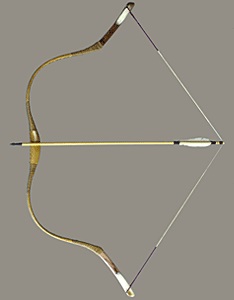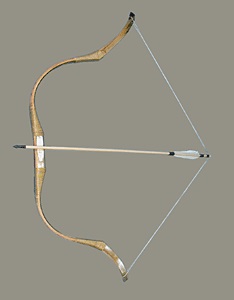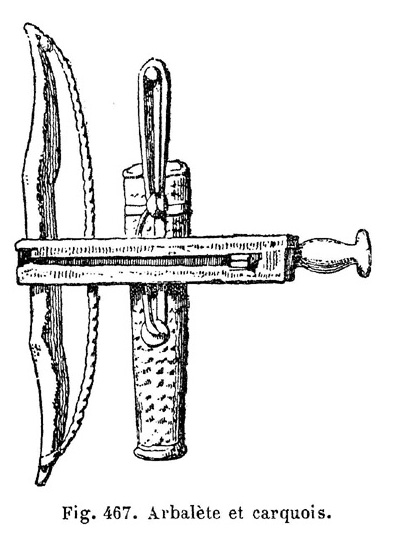The Arcus Romanus
WHERE TO BUY:
Grozer Archery - Sells a Roman infantry bow. Very affordable, very accurate, a great bowmaker!
The Arcus Hunniscus
WHERE TO BUY:
Grozer Archery - Sells a Hunnic asymmetric bow. The extra three is the acceptable one, as it is the same style of composite materials the Huns used, but it is very expensive.
The Arcuballista
The late Romans invented the crossbow around the 3rd century AD, although they had been using a handheld version of the scorpio called a "manuballista" since the 2nd century AD. The Arcuballista wasn't exceptionally powerful, as it used wooden rather than Iron arms, but was easy to use and maintain. There have actually been 3 finds of Arcuballista parts, dating to the 5th and 6th centuries in Britain. Many of them were decorated on the sides with carved bone strips inserted into the stock. These also may have had some sort of effect when the bow fired, possibly stiffening the wood.
The Arcuballista was a composite bow about 150cm in length, inserted into about a 90cm stock, with a 80cm grove for the arrow. At the back of the groove behind the bolt should be a bone or iron rolling nut, attached to a metal Z-bar, which acts as a trigger. The string should be natural rope or sinew, and bone nuts can only take so much draw weight, so it is recommended for higher draws you use an iron nut. The handle should be attached to the back of the stock.
An easier configuration is the sliding handle configuration, which has a flat nut on a pivot above the handle, that is kept from dropping by the insert of the handle into the wood. The handle is then pulled back, dropping the front of the nut and allowing the crossbow to fire.
- It is recommended a spring is mounted onto the Z-bar to reset the the firing mechanism, as we know the Romans used these all the time in doorknobs.
- The draw weight varies - do what is appropriate for you, but it shouldn't go above 80-90 pounds maximum.
- To span the crossbow, it is not spanned like a medieval one as that would break the arms. Instead place the arms perpendicular to you, with your legs spread on either side, with one hand on the handle and the other drawing the string. This is how you span the Arcuballista.
Arrows, Bolts
Arrows of this era were made with ash shafts and had feather fletching, secured with sinew and tar. The heads were socketed, and usually leaf-bladed or pyramidal, but steppe heads could take other shapes.
WHERE TO BUY:
Grozer Archery - Sells Roman arrows (Type B or D, with arrowheads C-1, C-2, and C-4)
Grozer Archery - Sells Hunnic arrows (Type B or D, with arrowheads A-7, A-8, and C-4)
WHERE TO BUY:
Grozer Archery - Sells crossbow bolts (Type B, with arrowheads C-3 or D-7)
Quivers and Accessories
As for vambraces, handguards, and other accessories, the Romans did not use these. In fact, the Romans did not even use a thumb ring, although the Huns may have. The reason for this is unknown, but it is likely it hadn't been introduced enough or adopted yet.
COMITATUS GUIDE TO ROMAN ARCHERY
GROZER GUIDE TO BOW MAINTINENCE AND STRINGING


